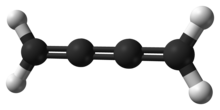
A cumulene is a compound having three or more cumulative (consecutive) double bonds.[1] They are analogous to allenes, only having a more extensive chain. The simplest molecule in this class is butatriene (H2C=C=C=CH2), which is also called simply cumulene. Unlike most alkanes and alkenes, cumulenes tend to be rigid, comparable to polyynes. Cumulene carbenes H2Cn for n from 3 to 6 have been observed in interstellar molecular clouds[2][3] and in laboratory experiments[4] by using microwave and infrared spectroscopy. (The more stable cumulenes H2CnH2 are difficult to detect optically because they lack an electric dipole moment.) Cumulenes containing heteroatoms are called heterocumulenes;[5] an example is carbon suboxide.
YouTube Encyclopedic
-
1/5Views:3137 13117 0014744 277
-
Easy way to understand stereochemistry of Cumulenes, Spiro and biphenyl compounds.
-
CiQUS and IBM Research Scientists First to Image Short-lived Molecules
-
Chiral Molecules With No Chiral Centers
-
R/S Nomenclature in Biphenyls
-
F.Sc, Part-2, Ch#7,Geometrical isomerism I Cis trans isomerism
Transcription
Synthesis
The first reported synthesis of a butatriene is that of tetraphenylbutatriene in 1921.[6] The most common synthetic method for butatriene synthesis is based on reductive coupling of a geminal dihalovinylidene.[7] Tetraphenylbutatriene was reported synthesized in 1977 by homocoupling of 2,2-diphenyl-1,1,1-tribromoethane with elemental copper in dimethylformamide.[8]
Structure

The rigidity of cumulenes arises from the fact that the internal carbon atoms carry double bonds. Their sp hybridisation results in two π bonds, one to each neighbor, which are perpendicular to each other. This bonding reinforces a linear geometry of the carbon chain.
Cumulenes with non-equivalent substituents on each end exhibit isomerism. If the number of consecutive double bonds is odd, there is cis–trans isomerism as for alkenes. If the number of consecutive double bonds is even, there is axial chirality as for allenes.
Transition metal cumulenes
The first reported complex containing a vinylidene ligand was (Ph2C2Fe2(CO)8, derived from the reaction of diphenylketene and Fe(CO)5 Structurally, this molecule resembles Fe2(CO)9, wherein one μ-CO ligand is replaced by 1,1-diphenylvinylidene, Ph2C2. The first monometallic vinylidene complex was (C5H5)Mo(P(C6H5)3)(CO)2[C=C(CN)2]Cl.[9]
See also
- Cyclopropatriene and cyclohexahexaene, cyclic cumulenes
References
- ^ IUPAC, Compendium of Chemical Terminology, 2nd ed. (the "Gold Book") (1997). Online corrected version: (2006–) "cumulenes". doi:10.1351/goldbook.C01440
- ^ Thaddeus, P.; Gottlieb, C.A.; Mollaaghababa, R.; Vrtilek, J.M. (1993). "Free carbenes in the interstellar gas". J. Chem. Soc., Faraday Trans. 89 (13): 2125. doi:10.1039/ft9938902125. ISSN 0956-5000.
- ^ Cabezas, C.; Tercero, B.; Agúndez, M.; et al. (2021). "Cumulene carbenes in TMC-1: Astronomical discovery of I\-H2C5". Astronomy & Astrophysics. 650: L9. doi:10.1051/0004-6361/202141274. ISSN 0004-6361. PMC 7611420.
- ^ McCarthy, M. C.; Travers, M. J.; Kovács, A.; et al. (1997). "Detection and Characterization of the Cumulene Carbenes H2C5 and H2C6". Science. 275 (5299): 518–520. doi:10.1126/science.275.5299.518. ISSN 0036-8075.
- ^ IUPAC, Compendium of Chemical Terminology, 2nd ed. (the "Gold Book") (1997). Online corrected version: (2006–) "heterocumulenes". doi:10.1351/goldbook.H02797
- ^ Brand, K. (17 September 1921). "Über Untersuchungen in der Tetraarylbutan-Reihe und über das 1.1 4.4-Tetraphenyl-butatrien. (4. Mitteilung über die Reduktion organischer Halogen-verbindungen.)". Berichte der Deutschen Chemischen Gesellschaft (A and B Series). 54 (8): 1987–2006. doi:10.1002/cber.19210540828.
- ^ Leroyer, Léo; Maraval, Valérie; Chauvin, Remi (2012). "Synthesis of the Butatriene C4 Function: Methodology and Applications". Chemical Reviews. 112 (3): 1310–1343. doi:10.1021/cr200239h. ISSN 0009-2665. PMID 22040177.
- ^ Kunieda, Takehisa; Takizawa, Takeo (1977). "Convenient preparation of tetraarylbutatrienes". Chemical & Pharmaceutical Bulletin. 25 (7): 1809–1810. doi:10.1248/cpb.25.1809.
- ^ King, R. Bruce (August 2004). "The beginnings of terminal vinylidene metal complex chemistry through the dicyanomethylene/oxygen analogy: dicyanovinylidene transition metal complexes". Coordination Chemistry Reviews. 248 (15–16): 1533–1541. doi:10.1016/j.ccr.2004.05.003.
